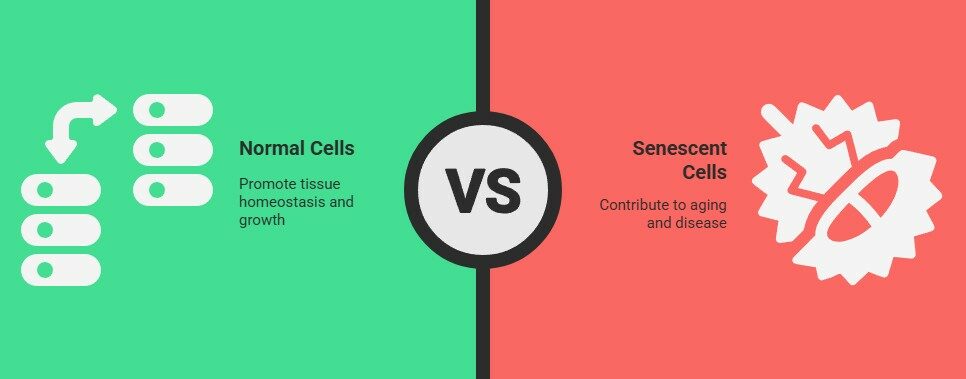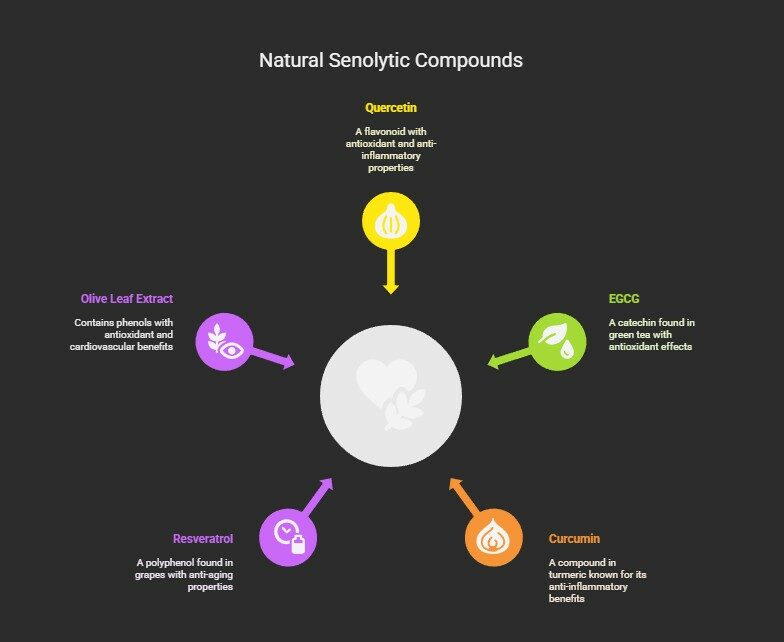Senolytics: The Revolutionary Breakthrough Against Aging

Table of Contents
Welcome to the fascinating world of senolytics – a groundbreaking class of compounds that are transforming how we approach aging and longevity.
What are the senolytics?
Senolytics are natural or synthetic compounds that help clear senescent cells — aging cells that no longer divide but trigger inflammation and damage nearby tissues.
By removing these “zombie cells,” senolytics promote healthier aging, boost energy, and support better cellular function throughout the body.
How to eliminate the “zombie cells” silently aging your body?
As you read this, your body contains millions of damaged cells called senescent cells that have stopped functioning properly but refuse to die.
These cellular “zombies” are quietly sabotaging your health, contributing to everything from wrinkles and joint pain to serious diseases like cancer and heart disease.
But here’s the exciting news: senolytics offer a revolutionary solution to target and eliminate these harmful cells, potentially slowing down aging and helping you live a healthier, longer life.
Are you ready to discover how this cutting-edge science could change your approach to aging?
Let’s explore this remarkable breakthrough together and learn how you can harness its power for your own health and longevity.
Understanding senescent cells: Why your body’s “zombie cells” are aging you faster?
Before we dive into senolytics, it’s crucial to understand what we’re fighting against.
Senescent cells, often called “zombie cells,” are cells that have reached the end of their productive life cycle but stubbornly refuse to die through the normal process of apoptosis (programmed cell death).
Think of senescent cells like retired employees who won’t leave the office – they’re no longer doing productive work, but they’re taking up space and creating problems for everyone else.

Here’s what makes them so problematic:
The cellular aging process explained
Cellular senescence initially evolved as a protective mechanism. When cells experience damage from factors like:
- DNA mutations
- Oxidative stress from free radicals
- Telomere shortening
- Chronic inflammation
- Environmental toxins
They stop dividing to prevent potentially cancerous mutations from spreading.
This is actually your body’s wise defense system at work!
However, the problem arises when these cells accumulate over time without being cleared away by your immune system.
The SASP phenomenon: How zombie cells poison your body?
Here’s where things get concerning. Senescent cells don’t just sit quietly – they actively secrete a cocktail of harmful substances called SASP (Senescence-Associated Secretory Phenotype).
This inflammatory mixture includes:
- Pro-inflammatory cytokines (like IL-6 and TNF-α)
- Matrix metalloproteinases that break down healthy tissue
- Growth factors that can promote tumor development
- Chemokines that attract immune cells and perpetuate inflammation
This toxic secretion creates a domino effect, causing nearby healthy cells to become senescent and contributing to the chronic, low-grade inflammation that drives aging and age-related diseases.
Ask yourself: Have you noticed increased joint stiffness, slower healing, or reduced energy as you’ve gotten older?
These could be signs that senescent cells are accumulating in your body.
The science behind senolytics: How they target aging at the cellular level?
Senolytics represent a paradigm shift in anti-aging science. Unlike traditional approaches that treat symptoms, senolytics address one of the root causes of aging by selectively eliminating problematic senescent cells while leaving healthy cells untouched.
The selective targeting mechanism
What makes senolytics so remarkable is their precision. These compounds exploit specific vulnerabilities that distinguish senescent cells from healthy ones:
- Altered apoptosis pathways: Senescent cells have disrupted cell death mechanisms, making them resistant to dying naturally. Senolytics can override these protective mechanisms.
- Increased anti-apoptotic proteins: Zombie cells produce excess proteins (like BCL-2, BCL-xL) that prevent cell death. Senolytics can inhibit these “survival” proteins.
- Enhanced stress responses: Senescent cells are more vulnerable to certain types of cellular stress that healthy cells can easily handle.
- Metabolic differences: These aged cells have altered energy production and waste disposal systems that senolytics can target.
The apoptosis activation process
When senolytics encounter senescent cells, they essentially “flip the switch” on programmed cell death by:
- Inhibiting anti-apoptotic proteins
- Activating pro-apoptotic pathways
- Triggering mitochondrial dysfunction in targeted cells
- Allowing natural cell death processes to resume
The result? Your immune system can finally clear away these cellular zombies, reducing inflammation and allowing healthy tissue regeneration to occur.
7 proven benefits of senolytic therapy: What the research reveals
The scientific evidence for senolytics is rapidly accumulating, with studies showing remarkable improvements across multiple health parameters. Here’s what research has demonstrated:
1. Enhanced physical performance and mobility
Clinical trials have shown that senolytic treatment can significantly improve:
- Walking speed and endurance
- Grip strength and muscle function
- Balance and coordination
- Overall physical frailty scores
A landmark study published in Nature Medicine found that participants treated with dasatinib and quercetin showed measurable improvements in physical function within just 11 days of treatment.
2. Cardiovascular health improvements
Your heart and blood vessels accumulate senescent cells over time, contributing to:
- Arterial stiffening
- Atherosclerosis development
- Reduced cardiac function
- Increased blood pressure
Senolytics have shown promise in:
- Improving blood vessel elasticity
- Reducing arterial plaque formation
- Enhancing heart muscle function
- Lowering cardiovascular disease risk
3. Joint health and osteoarthritis relief
Senescent cells in cartilage and surrounding tissues contribute significantly to joint degeneration. Research indicates that senolytics can:
- Reduce joint inflammation
- Slow cartilage breakdown
- Improve joint mobility
- Decrease pain and stiffness
Wonder if this applies to you? If you experience morning joint stiffness or decreased range of motion, senescent cell accumulation might be a contributing factor.
4. Cognitive function and brain health
The brain is particularly vulnerable to senescent cell accumulation, which can contribute to:
- Neuroinflammation
- Reduced neuroplasticity
- Memory decline
- Increased risk of neurodegenerative diseases
Studies suggest senolytics may help:
- Improve memory and learning
- Enhance neuronal connectivity
- Reduce brain inflammation
- Support healthy aging of the nervous system
5. Improved metabolic health
Senescent cells in fat tissue and organs involved in metabolism can disrupt:
- Insulin sensitivity
- Glucose regulation
- Lipid metabolism
- Energy production
Senolytic therapy has shown potential to:
- Enhance insulin sensitivity
- Improve glucose tolerance
- Support healthy weight management
- Optimize metabolic function
6. Enhanced tissue repair and wound healing
As we age, our ability to heal from injuries slows dramatically. Senescent cells contribute to this by:
- Impairing stem cell function
- Reducing growth factor production
- Maintaining chronic inflammation
- Disrupting tissue remodeling
Senolytics can help restore:
- Faster wound healing
- Improved tissue regeneration
- Enhanced stem cell activity
- Reduced scarring
7. Increased lifespan and healthspan
Perhaps most remarkably, animal studies have consistently shown that senolytic treatment can:
- Extend maximum lifespan by up to 36%
- Improve quality of life during aging
- Delay onset of age-related diseases
- Maintain youthful function longer
While human longevity studies are still ongoing, the preliminary evidence is incredibly promising.

Types of senolytics: From prescription drugs to natural compounds
The field of senolytics includes both pharmaceutical drugs and natural compounds, each with unique mechanisms and benefits:
Pharmaceutical senolytics
- Dasatinib + Quercetin (D+Q) combination
- Dasatinib: Originally a cancer drug that inhibits multiple kinases
- Quercetin: A natural flavonoid that enhances the senolytic effect
- Mechanism: Targets different senescent cell populations synergistically
- Research status: Most studied combination with proven human efficacy
- Considerations: Requires medical supervision due to potential side effects
- Navitoclax (ABT-263)
- Mechanism: Potent BCL-2 family protein inhibitor
- Advantages: Highly effective at eliminating senescent cells
- Limitations: Can cause thrombocytopenia (low platelet count)
- Status: Primarily used in research settings
- Fisetin
- Source: Natural flavonoid found in strawberries, apples, and persimmons
- Advantages: Generally well-tolerated with minimal side effects
- Mechanism: Selectively induces apoptosis in senescent cells
- Availability: Can be obtained as a dietary supplement
Natural senolytic compounds

- Quercetin
- Sources: Onions, apples, berries, green tea
- Benefits: Anti-inflammatory, antioxidant, and senolytic properties
- Dosage: Typically 500-1000mg daily
- Enhancement: Better absorbed when combined with bromelain
- EGCG (Epigallocatechin gallate)
- Source: Green tea extract
- Mechanism: Modulates multiple cellular pathways involved in senescence
- Additional benefits: Neuroprotective and metabolic support
- Optimal intake: 400-800mg daily between meals
- Curcumin
- Source: Turmeric root
- Properties: Powerful anti-inflammatory and senolytic effects
- Bioavailability: Enhanced with piperine (black pepper extract)
- Traditional use: Thousands of years in Ayurvedic medicine
- Resveratrol
- Sources: Red grapes, berries, dark chocolate
- Mechanism: Activates sirtuins and reduces senescent cell burden
- Synergy: Works well combined with other polyphenols
- Research: Extensive studies on longevity benefits
- Olive leaf extract and olive phenols
- Active compounds: Oleuropein, hydroxytyrosol
- Benefits: Potent antioxidant and anti-inflammatory effects
- Mediterranean connection: May explain longevity in Mediterranean populations
- Usage: Available as standardized extracts
Comprehensive senolytic formulations
Modern supplement science has led to the development of comprehensive senolytic formulas that combine multiple active compounds for synergistic effects. These typically include:
- Primary senolytics (quercetin, fisetin)
- Supporting antioxidants (EGCG, resveratrol)
- Bioavailability enhancers (piperine, phospholipids)
- Autophagy activators (spermidine, urolithin A)
Looking for a convenient option? These multi-ingredient formulas can provide comprehensive senolytic support without the need to take multiple separate supplements.
How to incorporate senolytics into your anti-aging routine?
Ready to harness the power of senolytics for your own health and longevity? Here’s your practical guide to getting started:
The intermittent dosing approach
Unlike daily supplements, many senolytics work best when taken intermittently. This approach, called “hit-and-run” therapy, involves:
Cycle 1: Loading phase
- Take senolytic compounds for 2-3 consecutive days
- Allow 1-2 weeks for cellular cleanup and recovery
- Monitor how your body responds
Cycle 2: Maintenance phase
- Repeat the 2-3 day protocol monthly or bi-monthly
- Adjust frequency based on age, health status, and goals
- Consider seasonal cycles (e.g., quarterly cleanses)
Beginner-friendly senolytic protocol
If you’re new to senolytics, start with these gentle, natural options:
Week 1-2: Begin with quercetin
- 500mg twice daily with meals
- Combine with 100mg bromelain for enhanced absorption
- Monitor for any digestive sensitivity
Week 3-4: Add EGCG
- 400mg between meals on an empty stomach
- Take with vitamin C to enhance stability
- Avoid within 2 hours of iron-rich foods
Month 2: Introduce curcumin
- 500mg with piperine daily
- Take with a meal containing healthy fats
- Consider starting with every other day
Advanced senolytic strategies
For those ready to take a more aggressive approach:
Monthly intensive cycles:
- Days 1-3: High-dose quercetin (1000mg) + fisetin (500mg)
- Days 4-7: Recovery period with antioxidant support
- Weeks 2-4: Maintenance doses of supporting compounds
Seasonal deep cleanses:
- 4 times per year (solstices and equinoxes)
- Combine multiple senolytics for 3-5 days
- Include fasting or autophagy-enhancing practices
Meet Senolytic-Q – your ready-made formula for cellular renewal
Instead of juggling multiple supplements and complex dosing schedules, Senolytic-Q brings you a synergistic blend of proven senolytics like quercetin, fisetin, and luteolin — all in one precision-designed solution. This is not just another supplement.
It’s a modern breakthrough in the science of aging, created to target senescent cells, boost autophagy, and help you reclaim your energy, clarity, and mobility.
Let’s explore how it works – and why it could be the smartest upgrade to your longevity routine.
Lifestyle factors that enhance senolytic effectiveness
Maximize your results by combining senolytics with these proven longevity practices:
- Intermittent fasting
- Enhances autophagy (cellular cleanup)
- Increases stress resistance
- Complements senolytic mechanisms
- Regular exercise
- Promotes healthy cell turnover
- Reduces systemic inflammation
- Improves immune system function
- Quality sleep
- Essential for cellular repair processes
- Supports immune system cleanup of senescent cells
- Optimizes hormone production
- Stress management
- Chronic stress accelerates cellular senescence
- Meditation and mindfulness practices help
- Consider adaptogenic herbs as support
- Anti-inflammatory diet
- Emphasize polyphenol-rich foods
- Minimize processed foods and sugar
- Include omega-3 fatty acids
Safety considerations and potential side effects
While senolytics offer exciting possibilities, it’s important to approach them responsibly:
Common side effects and how to minimize them:
Digestive upset:
- Start with lower doses and gradually increase
- Take with food if stomach sensitivity occurs
- Consider digestive enzymes or probiotics
Detox symptoms:
- Temporary fatigue or headaches are possible
- Increase water intake and support liver function
- Reduce dose if symptoms are severe
Drug interactions:
- Quercetin may interact with certain medications
- Consult healthcare providers if taking blood thinners
- Monitor blood sugar if diabetic
Who should exercise caution?
- Pregnant or nursing women: Avoid senolytics during pregnancy and breastfeeding
- People on medication: Especially blood thinners, diabetes medications, or chemotherapy
- Those with bleeding disorders: Some senolytics may affect clotting
- Individuals with autoimmune conditions: May need modified protocols
Always consult with a knowledgeable healthcare provider before starting any senolytic regimen, especially if you have existing health conditions or take medications.
The future of senolytic therapy: What’s coming next?
The field of senolytics is rapidly evolving, with exciting developments on the horizon:
Emerging senolytic compounds
Researchers are continuously discovering new senolytic agents:
- HSP90 inhibitors: Targeting heat shock proteins in senescent cells
- Galacto-oligosaccharides: Natural compounds that may enhance senolytic effects
- Engineered molecules: Designer drugs with improved specificity and reduced side effects
Personalized senolytic therapy
The future may include:
- Biomarker testing: Measuring senescent cell burden in individuals
- Genetic profiling: Customizing protocols based on genetic variants
- AI-guided dosing: Using machine learning to optimize treatment protocols
Combination therapies
Promising research is exploring:
- Senolytics + stem cell therapy: Clearing old cells while promoting regeneration
- Senolytics + immunotherapy: Enhancing the body’s natural cleanup mechanisms
- Senolytics + metabolic interventions: Combining with caloric restriction mimetics
Start your journey toward cellular rejuvenation today
The science of senolytics represents one of the most exciting breakthroughs in anti-aging research. By understanding how to selectively eliminate senescent cells, we’re gaining unprecedented control over the aging process itself.
Are you ready to take the first step toward a younger, healthier you? Remember, the best time to start addressing cellular aging is before you feel its full effects. Whether you’re looking to maintain your current vitality or reverse some of the signs of aging you’re already experiencing, senolytics offer a scientifically-backed approach to cellular rejuvenation.
Your action plan starts now:
- Assess your current health status and consider consulting with a longevity-focused healthcare provider
- Start with gentle, natural senolytics like quercetin and EGCG
- Implement supporting lifestyle practices like intermittent fasting and regular exercise
- Monitor your progress through both subjective improvements and objective measures
- Stay informed about new developments in senolytic research
The future of aging is in your hands. Every day you wait is another day that senescent cells continue to accumulate in your body, potentially accelerating the aging process. But every day you take action is a step toward maintaining your health, vitality, and independence as you age.
Take control of your cellular health today – your future self will thank you for making this investment in longevity and quality of life.
Scientific references
- Lagoumtzi, S.M., & Chondrogianni, N. (2021). Senolytics and Senomorphics: natural and synthetic therapeutics in the treatment of aging and chronic diseases. Free Radical Biology and Medicine, 171, 169-190. https://pubmed.ncbi.nlm.nih.gov/34019945/
- Kang, C. (2019). Senolytics and Senostatics: A Two-Pronged Approach to Target Cellular Senescence for Delaying Aging and Age-Related Diseases. Molecules, 24(21), 3803. https://pubmed.ncbi.nlm.nih.gov/31640147/
- Kirkland, J.L., & Tchkonia, T. (2020). Senolytic drugs: from discovery to translation. Nature Medicine, 26(10), 1533-1540. https://pubmed.ncbi.nlm.nih.gov/33020644/
- Xu, M., et al. (2018). Senolytics improve physical function and increase lifespan in old age. Nature Medicine, 24(8), 1246-1256. https://pubmed.ncbi.nlm.nih.gov/30082871/
- Hickson, L.J., et al. (2019). Senolytics decrease senescent cells in humans: Preliminary report from a clinical trial of Dasatinib plus Quercetin in individuals with diabetic kidney disease. EBioMedicine, 47, 446-456. https://pubmed.ncbi.nlm.nih.gov/31542391/
- Justice, J.N., et al. (2019). Senolytics in idiopathic pulmonary fibrosis: Results from a first-in-human, open-label, pilot study. EBioMedicine, 40, 554-563. https://pubmed.ncbi.nlm.nih.gov/30616998/
- Zhu, Y., et al. (2015). The Achilles’ heel of senescent cells: from transcriptome to senolytic drugs. Aging Cell, 14(4), 644-658. https://pubmed.ncbi.nlm.nih.gov/25754370/
